|
1. Disease management of Agricultural Crops
2. Disease Management of Horticultural Crops
2. Disease Management of Horticultural Crops
Fruit Crops
Diseases of Mango
Anthracnose (Colletotrichum gloeosporioides)
Symptoms
- Produces leaf spots, blossom blight, wither tip, twigs blight and fruit rot.
- Small blister like spots develop on the leaves and twigs. Young leaves wither and dry Tender twigs wither and die back symptom appears.
- Affected branches ultimately dry up. Black spots appear on fruits.
- The fruit pulp becomes hard, crack and decay at ripening. Infected fruits drop

Mode of survival and spread
- on dried leaves, defoliated branches mummified flowers and flower brackets.
- Contact with diseased fruit during transport and storage. The secondary spread is through airborne conidia
Favourable conditions
- Temperature of 25°C and Relative Humidity 95-97%
Management
- Before storage, treat with hot water, (50-55°C) for 15 minutes
Mango malformation (Fusarium moliliforme var. subglutinans)
Symptoms
- Three types of symptoms: bunchy top phase, floral malformation and vegetative malformation.
- In bunchy top phase in nursery bunch of thickened small shoots, bearing small rudimentary leaves. Shoots remain short and stunted giving a bunchy top appearance.
- In vegetative malformation, excessive vegetative branches of limited growth in seedlings. They are swollen with short internodes forming a bunches of various size and the top of the seedlings shows bunchy top appearance.
- In malformation of inflorescens, shows variation in the panicle. Malformed head dries up in black massesa and persist for long time.
- Secondary branches are transformed into number of small leaves giving a witches broome appearance.
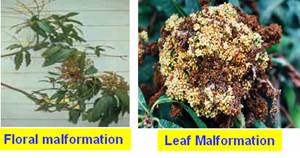
Mode of spread
- Diseased propagatives materials.
Management
- Diseased plants should be destroyed
- Use of disease free planting material
- Pruning of diseased parts along the basal 15-20 cm apparently healthy portions.
Grey Blight (Pestalotia mangiferae)
Symptoms
- Brown spots develop on the margin and at the tip of the leaf lamina. They increase in size and become dark brown. Black dots appear on the spots which are acervali of the fungus.
Mode of survival and spread
- Survive on mango leaves for over a year. Spreads through wind borne conidia.
Favourable conditions
- Heavy infection is noticed during the monsoon when the temperature is 20-25oC.and high humidity.
Management
- Remove and destroy infected plant parts.
Sooty mould (Capnodium mangiferae)
Symptoms
- The fungi produce mycelium which is superficial and dank.They row on sugary secretions of the plant hoppers. Black encrustation is formed which affect the photosynthetic activity.
Favourable conditions
- The fungus grows on the leaf surface on the sugary substances secreted by Jassids,Aphids and scale insects.
Management
- Management should be done for insects and sooty moulds simultaneously.
- Starch dries and forms a flake which are removed along with the fungus.
Diseases of Citrus
Gummosis (Phytophthora parasitica, P. palmivora, P. citrophthora)
Symptoms
- First symptoms are dark staining of bark which progresses into the wood.
- Bark at the base is destroyed resulting in girdling and finally death of the tree.
- Bark in such parts dries, shrinks and cracks and shreds in lengthwise vertical strips.
- Later profuse exudation of gum from the bark of the trunk.
- Infection extends to crown roots.

Favourable conditions
- Prolonged contact of trunk with water as in flood irrigation; water logged areas and heavy soils.
Mode of spread and survival
- Soil inhabitants.
- Sporangia spread by splashing rain water, irrigation water and wind.
- Irrigation water and wind.
Management
- Injuries to crown roots or base of stem during cultural operations should be avoided.
- If lesion has girdled less than ½ the girth, remove the diseased bark with a knife along with ½” of uninvaded bark.
Canker (Xanthomonas campestris pv citri)
Symptoms
- Acid lime, lemon and grapefruit are affected. Rare on sweet oranges and mandarins.
- Affects leaf, twig and fruits. In canker, leaves are not distorted.
- Lesions are typically circular with yellow coloured; appear on both sides of leaf, severe in acid lime (difference from scab) When lesions are produced on twigs, they are girdled and die.
- On fruits, canker lesions reduce market value.
 
Favourable conditions
- At 20-30°C,free of moisture.
Mode of survival and spread
- Wind and rain splashes.
- Survives in infected leaves for 6 months.
- Injury caused by leaf miner helps the entry of the bacterium.
Management
- Control leaf miner when young flush is produced.
- Prune badly infected twigs before the onset of monsoon.
Tristeza or quick decline (Virus)
Symptoms
- Lime is susceptible both as seedling or buddling on any root stock.
- But mandarin and sweet orange seedlings or on rough lemon, trifoliate orange, citrange; Rangpur lime root stocks tolerant; susceptible root stocks are grapefruit and sour orange.
- In sweet orange or mandarin on susceptible root stocks, leaves develop deficiency symptoms and absise.
- Roots decay, twigs die back. Fruit set diminishes; only skeleton remains.
- Fine pitting of inner face of bark of sour orange stock.
- Grapefruit and acid lime are susceptible irrespective of root stock.
- Tree stunted and dies yield very much reduced. Fruits are small in size.
Mode of spread
- Use of infected bud wood Toxoptera citricida (aphid) is the important vector.
Management
- For sweet orange and mandarin. Avoid susceptible root stocks.
- For acid lime, use seedling preimmunised with mild strain of tristeza.
Greening (Liberobactor asiaticum) (Phloem limited Bactria- like- organism)
Symptoms
- This disease affects almost all citrus varieties irrespective of root stock.
- Stunting of leaf, sparse foliation, twig die back, poor crop of predominantly greened, worthless fruits.
- Sometimes only a portion of tree is affected.A diversity of foliar chlorosis.
- A type of mottling resembling zinc deficiency often predominates.
- Young leaves appear normal but soon assume on outright position, become leathery and develop prominant veins and dull olive green colour. Green circular dots on leaves.
- Many twigs become upright and produce smaller leaves.
- Fruits small, lopsided with curved columella. The side exposed to direct sunlight develops full orange colour but the other side remain dull olive green.
- Low in juice and soluble solids, high in acid. Worthless either as fresh fruit or for processing. Seeds poorly developed, dark coloured, aborted.
Mode of spread
- Infected budwood; psyllid vector-Diaphorina citri
Management
- Control psyllids with insecticides.
- Use pathogen free bud wood for propagation.
Diseases of Guava
Anthracnose (Colletotrichum gloeosporioides)
Symptoms
- Symptoms of this disease are observed on mature fruits on the tree.
- The characteristic symptoms consist of sunken, dark colored, necrotic lesions. Under humid conditions, the necrotic lesions become covered with pinkish spore masses.
- As the disease progresses, the small sunken lesions coalesce to form large necrotic patches affecting the flesh of the fruit
Management
- Control measures are needed in commercial guava production.
- The use of resistant cultivars provides the most efficient tactic in disease management.
Guava Rust (Puccinia psidii)
Symptoms
- The pathogen can affect foliage, young shoots, inflorescences and fruit of guava.
- Typical symptoms associated with this disease include distortion, defoliation, reduced growth and if severe, mortality.
- On fully expanded leaves, dark bordered, roughly circular brown lesions with yellow halos develop
Management
- Control of guava rust is based on the use of fungicides.
- Scouting fields for onset of disease or during the times of year when environmental conditions are favorable for pathogen infection are recommended so that proper and timely fungicide applications can be made.
- In addition, proper cultural tactics such as proper fertilization, irrigation, pruning and sanitation aide in achieving a healthy, vigorously growing tree less vulnerable to disease pressures.
Guava Diseases Caused by Nonfungal Agents (Cephaleuros virescens)
Algal Leaf Spot
Symptoms
- Disease symptoms are exhibited on both abaxial and adaxial leaf surfaces as orange, rust-colored, dense silky tufts ranging from 5 to 8 mm in diameter.
- Upon scraping away these spots, a thin, grayish white to dark-colored, necrotic crust remains on the leaf.
- These spots usually come together to form large irregular patches on a leaf. As the spots mature they take on a dull, grayish green color.
- Twigs and branches are also affected causing the bark to crack due to the growth and expansion of the pathogens filaments into the cortical tissues of the host.
Management
- Algal leaf spot can be reduced by maintaining tree vigor with cultural techniques such as proper fertilization and irrigation, proper pruning to enhance air circulation within the canopy and sunlight penetration, managing weeds and wider tree spacing. Managing insect, mite and other foliar diseases increases tree vigor and lessens susceptibility to this disease.
Diseases of Apple
Scab (Venturia inaequalis)
Symptoms
- Symptom appears on leaves and fruits.
- On lower side of the leaf lesion appear as olivaceous spots which turn dark brown to black and become velvety.
- On young foliage, the spots have a radiating appearance with a feathery edge.
- On older leaves the lesions are more definite in outline.
- The lesion may form a convex surface with corresponding concave area on the opposite side.
- In severe infection leaf blade curved, dwarfed and distorted.
- Fruits show small, rough, black circular lesions.
- The centre of the spots become corky and on mature fruits, yellow halo is seen around the lesions.
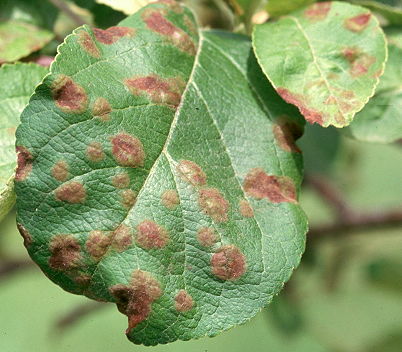 
Mode of spread and survival
- Primary spread through ascospores and secondary spread by air borne conidia.
- Favourable conditim
- Cool and moist conditions due to rain or show at higher elevation and shady portion.
Management
Clean cultivation, collection and destruction of fallen leaves
Fire blight (Erwinia amylovora)
- The initial symptom usually occurs on flowers, which become water soaked, then shrivel turn brownish to black in colour and fall or remain hanging in tree.
- The symptom spread to leaves twigs. Terminal twigs wilt from hip to downward and also spread to branches fruits becomes water soaked, turns brown, shrivels and findly becomes black.
- Oozing may be seen in the affected area.
Survival and spread
- The bacterium survives in infected branches and twigs. Secondary spread by insects and rain splash.
Favourable condition
- Temperature above 24ºC and heavy rain.
Management
- Removal and destruction of affected parts.
- cutting of blighted twigs and root sprouts in summer
Soft rot (Penicillium expansum)
Symptom
- Young spots starts from stem end of the fruit as light brown watery rot. As the fruit ripens area of the rotting increases,
- skin becomes wrinkled.
- A peculiar musty odour is emitted
- Under humid condition a bluish green sprorulating growth appears.
Mode of spread and survival
- Infection take place by wounds in the skin caused by insects and during handing in storage and transport.
Management
- Careful handling of fruits without causing any wounds.
Vegetable Crops
Diseases of Tomato
Damping Off (Pythium aphanidermatum)
Symptom
- This is one of the worst diseases of tomato occurring in the nursery.
- Damping off of tomato occurs in two stages, i.e. the pre-emergence and the post-emergence phase.
- In the pre-emergence the phase the seedlings are killed just before they reach the soil surface.
- The young radicle and the plumule are killed and there is complete rotting of the seedlings.
- The post-emergence phase is characterized by the infection of the young, juvenile tissues of the collar at the ground level.
- The infected tissues become soft and water soaked. The seedlings topple over or collapse.
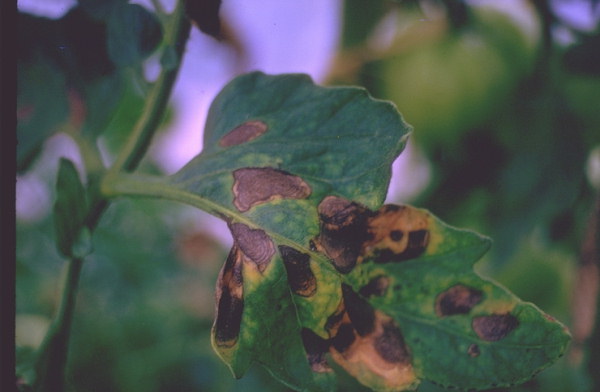 
Control
- Seed treatment with fungal culture Trichoderma viride (4 g/kg of seed)
Early Blight (Alternaria solani)
Symptom
- This is a common disease of tomato occurring on the foliage at any stage of the growth.
- The fungus attacks the foliage causing characteristic leaf spots and blight. Early blight is first observed on the plants as small, black lesions mostly on the older foliage.
- Spots enlarge, and by the time they are one-fourth inch in diameter or larger, concentric rings in a bull's eye pattern can be seen in the center of the diseased area.
- Tissue surrounding the spots may turn yellow. If high temperature and humidity occur at this time, much of the foliage is killed.
- Lesions on the stems are similar to those on leaves, sometimes girdling the plant if they occur near the soil line.
- Transplants showing infection by the late blight fungus often die when set in the field. The fungus also infects the fruit, generally through the calyx or stem attachment.
Control
- Removal and destruction of the affected plant parts. Practicing crop rotation helps to minimize the disease incidence.
Fusarium Wilt (Fusarium oxysporum f. sp. Lycopersici)
Symptom
- This is one of the worst diseases of tomato occurring mostly in the nurseries. The first symptoms of the disease are clearing of the veinlets and chlorosis of the leaves.
- The younger leaves may die in succession and the entire may wilt and die in a course of few days. Soon the petiole and the leaves droop and wilt.
- In young plants, symptom consists of clearing of veinlet and dropping of petioles. In field, yellowing of the lower leaves first and affected leaflets wilt and die.
- The symptoms continue in subsequent leaves. At later stage, browning of vascular system occurs. Plants become stunted and die.
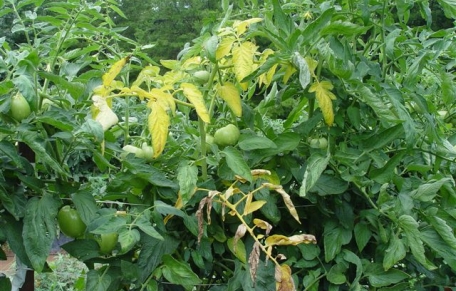 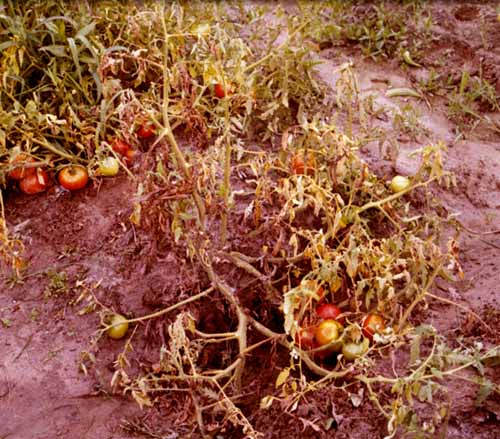
Control
- The nursery should be regularly inspected for wilt infected plants.
- The affected plants should be removed and destroyed.
- Prior to planting the beds should be drenched with Carbendazim (0.1%) and the seeds should be treated with the Thiram (2.5 kg/ha).
- Crop rotation with a non-host crop such as cereals helps to reduce the disease inoculum.
Septoria Leaf Spot (Septoria lycopersici)
Symptom
- The plant may be attacked at any stage of its growth. The disease is characterized by numerous, small, grey, circular leaf spots having dark border.
Control
- Removal and destruction of the affected plant parts.
Bacterial Wilt (Pseudomonas solanacearum)
Symptom
- This is one of the most serious diseases of tomato crop. Relatively high soil moisture and soil temperature favour disease development.
- Characteristic symptoms of bacterial wilt are the rapid and complete wilting of normal grown up plants.
- Lower leaves may drop before wilting. Pathogen is mostly confined to vascular region; in advantage cases, it may invade the cortex and pith and cause yellowbrown discolouration of tissues.
- Infected plant parts when cut and immersed in clear water, a white streak of bacterial ooze is seen coming out from cut ends.
Control
- Crop rotations, viz., cowpea-maize-cabbage, okra-cowpea-maize, maize- cowpea-maize and finger millet-egg plant are reported effective in reducing bacterial wilt of tomato.
- Seedling treatment with Streptocycline (1 g/40 litres of water) for 30 min protects the seedlings in the initial stages of growth.
Bacterial Leaf Spot (Xanthomonas campestris pv. Vesicatoria)
Symptom
- Moist weather and splattering rains are conducive to disease development. Most outbreaks of the disease can be traced back to heavy rainstorms that occur in the area.
- Infected leaves show small, brown, water soaked, circular spots surrounded with yellowish halo.
- On older plants the leaflet infection is mostly on older leaves and may cause serious defoliation.
- The most striking symptoms are on the green fruit. Small, water-soaked spots first appear which later become raised and enlarge until they are one-eighth to one-fourth inch in diameter.
- Centers of these lesions become irregular, light brown and slightly sunken with a rough, scabby surface.
- Ripe fruits are not susceptible to the disease. Surface of the seed becomes contaminated with the bacteria, remaining on the seed surface for some time.
- The organism survives in alternatehosts, on volunteer tomato plants and on infected plant debris.
Control
- Bacterial spot is difficult to control once it appears inthe field.
- Disease-free seed and seedlings should always be used and the crop should be rotated with non-host crops so as to avoid last years crop residue.
- Spraying with Agrimycin-100 (100 ppm) thrice at 10 days intervals effectively controls the disease.
Tomato Mosaic Virus (TMV)
Symptom
- The disease is characterized by light and dark green mottling on the leaves often accompanied by wilting of young leaves in sunny days when plants first become infected.
- The leaflets of affected leaves are usually distorted, puckered and smaller than normal. Sometimes the leaflets become indented resulting in "fern leaf" symptoms.
- The affected plant appears stunted, pale green and spindly.
- The virus is spread by contact with clothes, hand of working labour, touching of infected plants with healthy ones, plant debris and implements.
Control
- Seeds from disease free healthy plants should be selected for sowing. The seeds should be thoroughly rinsed and dried in shade.
- In the nursery all the infected plants should be removed carefully and destroyed. Seedlings with infected with the viral disease should not be used for transplanting.
- Crop rotation with crops other than tobacco, potato, chilli, capsicum, brinjal, etc. should be undertaken.
Tomato Leaf Curl Virus (TLCV)
Symptom
- This disease is transmitted by whitefly (Bemisia tabaci). It is one of the most devastating diseases of tomato.
- Leaf curl disease is characterized by severe stunting of the plants with downward rolling and crinkling of the leaves. The newly emerging leaves exhibit slight yellow colouration and later they also show curling symptoms.
- Older leaves become leathery and brittle. The nodes and internodes are significantly reduced in size.
- The infected plants look pale and produce more lateral branches giving a bushy appearance. The infected plants remain stunted.
Control
- The affected plants should be removed and destroyed. Alternate or collateral hosts harboring the virus causing this disease is removed at the time of weeding or earthing up operations to minimize the spread of the disease.
- Checking the white fly population can reduce the disease incidence.
Tomato Spotted Wilt Virus (TSWV)
Symptom
- The spotted wilt virus is transmitted through thrips (Thrips tabaci, Frankliniella schultzi and F. occidentalis).
- This disease is similar to streak in that it causes streaking of the leaves, stems and fruits. Numerous small, dark, circular spots appear on younger leaves.
- Leaves may have a bronzed appearance and later turn dark brown and wither.
- Fruits show numerous spots about one-half inch in diameter withconcentric, circular markings. On ripe fruit, these markings are alternate bands of red and yellow.
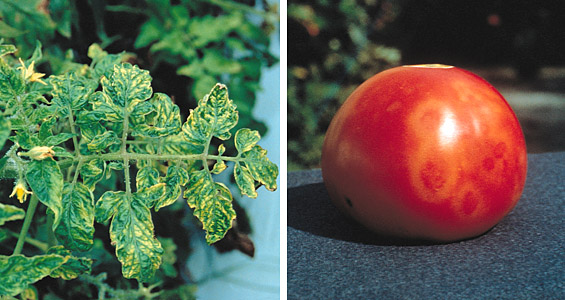
Control
- The affected plants should be removed and destroyed.
- Alternate or collateral hosts harboring the virus causing this disease is removed at the time of weeding or earthing up operations to minimize the spread of the disease.
Diseases of Brinjal
Bacterial Wilt (Pseudomonas solanacearum)
Symptoms
- Bacterial wilt symptoms on leaf surface Wilting, stunting, yellowing of the foliage and finally collapse of the entire plant are the characteristic symptoms of the disease.
- Lower leaves may droop first before wilting occurs.
- The vascular system becomes brown.
- Bacterial ooze comes out from the affected parts.
- Plant show wilting symptoms at noontime will recover at nights, but die soon.
Control
- Pant samrat variety is tolerant.
- Crop rotation with cruciferous vegetables such as cauliflower help in reducing the disease incidence.
- Fields should be kept clean and effected parts are to be collected and burnt.
- The disease is more prevalent in the presence of root knot Nematodes, so control of these nematodes will suppress the disease spread.
Cercospora Leaf Spot (Cercospora solani -melongenae, C. Solani)
Symptoms
Leaf spot symptoms
- The leaf spots are characterized by chlorotic lesions, angular to irregular in shape, later turn grayish-brown with profuse sporulation at the centre of the spot.
- Severely infected leaves drop off prematurely, resulting in reduced fruit yield.
Control
- Pant Samrat variety is resistant to both the leaf spots.
- Diseases can be managed by growing resistant varieties.
Tobacco mosaic virus (TMV)
Symptoms
- Mosaic mottling of leaves and stunting of plants are the characteristic symptoms of potato virus Y Mosaic symptoms are mild in early stages but later become severe.
- Infected leaves are deformed, small and leathery. Very few fruits are produced on infected plants.
- The important symptom produced by tobacco mosaic virus is conspicuous mottling of leaves.
- Leaves also develop blisters in advanced cases. Severely infected leaves become small and misshapen. Plants infected early remain stunted.
- PVY is easily sap transmitted.
- It is transmitted in the field through aphids, Aphis gossypii and Myzus persicae and perpetuates on weed hosts like Solanum nigrum and S.xanthocarpum.
- TMV is transmitted by sap, contaminated implements and clothes, soil debris and hands of labour.
- It can perpetuate on many cultivated plants like cucurbits, legumes, pepper, tobacco, tomato and weed hosts. The virus survives in plant debris in soil.
Control
- Destroy all weeds and avoid planting cucumber, pepper, tobacco, tomato near brinjal seed beds and field.
- Wash hands with soap and water before working in seed beds.
- Prohibit smoking or chewing of tobacco who are handling brinjal seedlings.
Collar Rot (Sclerotium rolfsii)
- The disease occasionally occurs in serious form.
Symptoms
- The lower portion of the stem is affected from the soil borne inoculum (sclerotia).
- Decortication is the main symptom.
- Exposure and necrosis of underlying tissues may lead to collapse of the plant.
- Near the ground surface on the stem may be seen the mycelia and sclerotia.
- Lack of plant vigour, accumulation of water around the stem, and mechanical injuries help in development of this disease.
Control
- Seed treatment with 4 g of Trichoderma viride formulation per kg seed will help in reducing the disease.
- Collection and destruction of diseased parts and portions of the plant.
Diseases of Cucurbits
Fusarium wilt of water melon (Fusarium oxysporum f. sp. Niveum), Muskmelon – F. o. fsp. Melonis
Symptoms
- The disease attack the plant at all stages of plant growth.
- When young seedlings are infected they damp off and die.
- In older plants the plant wilt and die within 10 days.
- Vascular discolaration can be seen. In wet weather, pinkish or whitish fungal growth can be seen on dead stems.
Mangement
- Collection and burning of infected plant.
- Seed treatment and soil application with T. Viride or P. fluorescens
- Use of disease free seeds.
Root rot of muskmelon (Pythium aphendermatum)
Root rot of pumpkin and squash (Fusarium solani f.sp. cucurbitae)
Root rot of watermelon, cucumber (Pythium irregulare and P.ultimum)
Symptoms
- The roots of the affected plants appear water soaked with sunken darkened lesions. The crown of the plants is girdled and entire plant is collapsed. Fruits become rotted by the fungus.
Management
- As like wilt the management practice should be followed.
Verticillium wilt (Verticillium albo-atrum)
Symptoms
- The leaves of the plant become yellow from base of the plant upwards and the whole plant wilts. If the stem is cut open, brown discoloration can be seen.
Anthracnose (Collectorichum lagenarium)
Symptoms
- Small yellowish or water soaked areas appears on leaves which enlarge rapidly and turn brown in most cucurbits but black in water melon. The affected bark break and fall of or the whole leaf dries. When the infection occurs in stem, the whole vine is killed. When infection occurs in fruit pedicle, the young fruit may be darken, shrivel and dry. Circular black cankers appear on fruits. The spots may be up to 5 cm dia based on the host and environment. In the sunken black spots salmon coloured spores can be seen.
Management
- Collection and destruction of infected plant.
Alternaria leaf spot/ target leaf spot / Macrosporium blight (Alternaria cucumerina, Macrosporium cucumerinum)
Symptoms
- Small, circular spots appear on leaves. As the spot enlarges concentric rings can be seen on infected area. The fungus also causes fruit rot
Management
- Use of disease free seeds.
Cercospora leaf spot (Cercospora citrullina)
Symptoms
- Small black circular spots with grey centre appear on leaves. Severely infected leaves fall off. The fruit size is reduced.
Management
- Collection and burning of infected leaf.
- Crop rotation.
Downy mildew (Pseudoperonospora cubensis)
Symptoms
- Symptoms resembling mosaic viz, pale green areas separated by dark green areas appear on upper surface of leaf. During wet season, corresponding lower surface is covered with faint purplish fungal growth. The entire leaf dries up quickly.
Management
- Use of bed system with wide spacing with good drainage and air movement and exposure to sun help to check the disease development.
Angular leaf spot (Pseudomonas syringae pv.lachrymans)
Symptoms
- Water soaked lesions appear on leaves which are confined to veins. Then turn grey to tan and form an exudates in the lower surface. The spots loosen and fall out. Infected fruits develop a brown, circular, superficial, firm rot which causes rapid detorition. The rot may extend into flesh.
Management
- Use of disease free seed and crop rotation.
Fruit rot (Pythium aphenidermatum)
Symptoms
- Initially the skin of the fruit shows soft, dark green water soaked lesions which gradually develop into a watery soft rot. Cottony mycelium develop on the affected portions. The fruit in contact with the soil is attacked easily.
Management
- Keep fruits not in touch with soil
Other fruit rots of watermelon
- Aspergillus fruit rot – Aspergillus flavus
- Curvularia fruit rot – Curvularia ovoidae
- Myrothecium fruit rot – Myrothecium roridum
- Rhizopus fruit rot – Rhizopus oryzae
- Diplodia fruit rot – Diplodia natalensis (also affects cucumber)
Viral disease
- Cucumber mosaic virus – Vector- aphids (A. craccivora M.persicae)
Symptoms
- Mosaic mottling, leaf distortion, stunting of the plants, shortened internode and petoles. Infected plants bear only very few flowers. In fruits mottled yellowish green areas can be seen.
Management
- Removal and burning of infected plants.
- Eradication weeds hosts
Other viral diseases
- Watermelon mosaic virus – watermelon and muskmelon
- Squash mosaic – Squash and pumpkin
- Mosaic disease – Bottle gourd, snake gourd, squash, ribbed gourd
Management
- Removal and burning of infected plants.
- Eradication weeds hosts
Phyllody – Phytoplasma (Vector – leaf hopper)
- It affects bitter gourd, bottle gourd, cucumber, ridge gourd and snake gourd. The symptoms are shortening of internodes and phyllody of normal flowers. Corolla, androecium and gynecium are transferred into green leaf like structures.
Management
- Removal of infected plants.
- Clean cultivation without weed host.
Diseases of French bean
Anthracnose
Symptoms: Brown canker on pods.
Management
Angular leaf spot
Symptoms: On the leaves there are angular red brown spots
Management
- Use healthy seeds.
- Adopt 2 year crop rotation in infected field.
Common Mosaic
Symptoms: Leaf turned curved due to etiolation and dry down near veins. There is less number of pods and seeds.
Management
- Grow resistant varieties e.g. contender
Diseases of Carrot
Black Root Rot (Thielaviopsis basicola)
- This can be a problem disease on carrots grown on muck or high organic soils.
- Washed carrots may show black scattered lesions when stored in polythene bags.
Management
- Avoid root damage
- Do not store in high temperature.
Cavity Spot (Pythium spp.)
Symptom
- Cavity spot occurs on both parsnips and carrots.
- Tonnage of the crop is not reduced but the cavities make the roots unmarketable.
- The disease occurs on carrots grown on mineral or peat (muck) soils.
Management
- No control for this disease is known other than growing carrots on new land free of this problem disease.
Common Scab (Streptomyces scabies)
Symptom
- This is the same scab that attacks potatoes and other root crops.
- Alkaline soils and dryish high organic soils are conducive to the development of the superficial disease.
- Scab lesions on the carrot surface.
Management
- Avoid potato fields and lower the soil pH if above 7 or more.
Cercospora Leaf Spot (Cercospora carotae)
Symptom
- This disease can be as destructive as Alternaria leaf blight.
- Again the disease is both seed- and residue-borne.
- Younger leaves are more susceptible than older leaves.
Management
- Ploughing under crop residues, crop rotation and foliar fungicides are all control recommendations.
Sclerotinia Rot - White Mould (Sclerotinia sclerotiorum)
Symptom
- The infectious ascospores of this fungus are abundant as a consequence of the build-up of the disease on millions of acres of canola and bean crops.
- Carrots may show little or no damage incidence in the field but following washing and storage white mold outbreaks often occur on the stored roots.
- Only a small percentage of the roots may be initially infected but the fungus mycelium can move very rapidly from carrot to carrot.
- In a matter of weeks the whole storage container may become a mass of white mold and black sclerotia surrounding each and every carrot.
Management
- Frequent inspection in storage, low temperatures, aeration.
Bacterial Leaf Blight (Xanthomonos campistris pv.carotae)
- A seed-borne bacterial disease that causes leaf spotting similar to Cerospora or Alternaria blights.
Diseases of Crucifers
Cabbage, cauliflower, turnip, broccoli are some of the important cruciferous crops
Club root (Plasmodiophora brassicae)
- The above ground symptoms are, yellowing of leaves, stunting and later the diseased plant die.
- Young plants die with in a short time while older plants fail to produce marketable heads.
- On roots and root lets, spindle shaped with thick centre and tapered ends giving a club shaped malformation is developed.
- The club shaped structered cells are invaded by the secondary,weakly parasitic organisms and the cells are disintegrated which produce toxins and the plants are killed.
Management
Black rot (Xanthomonas campestris pv.campestris)
- On leaves ‘V’ shaped chlorotic to yellow lesions develop from the leaf margins.
- They become black later. The veins and veinlets become black.Systemic infection spreads to the root.
- The vascular bundle in the stem becomes black followed by integration of fleshy stalk.
- The attack of soft rot organisms cause further detoriation.
- The cabbage heads and cauliflower curds are invaded and become discolored.
Management
- Use of healthy seed
- Spraying with Agrimycin 200 ppm
Alternaria leaf spot/ Black spot/ Brown spot (Alternaria brassicicola)
- Small dark coloured lesions up to 1.0 cm in dia appear on leaves.
- In humid condition conidiophores appear on the lesion in concentric rings.
- Linear spots also appear on petioles, stems and seed pods.
- On cauliflower curds brown discoloration occurs.
- In case of A.brassicae the spots are smaller in dia and lighter in colour.
Favourable condition
- Hot moist weather, temperature 26°
C. Dew or rain for 9 hrs is essential for infection.
Management
- Hot water treatment of seeds at 500C for 30 minutes.
- Crop rotation, avoiding overhead irrigation.
Wire Stem
- Wire stem gets its name from symptoms that occur on the stem at the soil level. A dark, watersoaked lesion initially appears on the stem.
- Later stems become wiry and slender at the point of the lesion.
- Diseased crucifer plants transplanted to the field grow poorly, are stunted, and may eventually die, especially if there is inadequate moisture shortly after transplanting.
- If infected plants remain alive, the stem becomes tough and woody. Plants that survive usually mature late and fail to produce a marketable head.
Bottom Rot
- Bottom rot is a disease of mature cabbage.
- After cabbage transplants become large enough to begin to shade the ground, the disease appears on the lower side of the head leaves that are in contact with the soil.
- The midrib is often the first part of the leaf attacked.
- Resulting lesions are sunken, black, and sharply elliptical with the long side of the lesion parallel to the side of the midrib.
- Lesions may dry out and become papery brown in appearance if the weather becomes dry.
- The surface of the lesion may be covered with a sparse, weblike mycelium.
- Eventually a general black decay occurs at the base of the leaf.
- The tip of the leaf then turns yellow and then the entire leaf wilts.
- Infected leaves are shed and only a naked stalk, capped with a small head, remains.
- Bottom rot becomes a head rot if temperatures are warm and the relative humidity is high.
- A weblike mycelium develops between diseased leaves.
- Infected leaves are eventually covered with small, brown, fungal structures called sclerotia, which can persist on plant debris in the soil for long periods of time.
- The stem remains unaffected, thus, the head remains upright.
Cultural Control
- Choose a fertile, well-drained site for the plant bed. Poor drainage favors seedling disease.
- Avoid excessive amounts of nitrogen fertilizer. Succulent plants are more susceptible to infection.
- Seed crucifers when the soil temperature reaches 69°F (21°C) and seed as shallowly as possible so that germination and emergence are rapid.
- Discard transplant seedlings that show symptoms of wire stem.
- Avoid banking or throwing soil up around plants during field cultivation.
- Harvest cabbage heads early. Cabbage leaves become more susceptible the longer they stand in the field.
Survival
- Sources of the fungus include infested seeds, cruciferous weeds, and residues of cruciferous crops remaining in or on the soil
- Survival in crop residues in soil for 3 years.
Management
- Use of disease free seed
- Rotation with non cruciferous crops for 4 years where the disease is severe
- Providing adequate drainage facility.
- Soil fumigation with chloropicrin etc.
Cabbage yellows / Fusarium wilt of cabbage (F. Oxysporum conglutians)
- The plant become yellow in colour.
- The wilting of leaves may be more prominent on one side of plant that the other.
- Leaves dries up. When the infected stem is cut open brown discoloration will be seen.
Management
- Use of disease free seed.Crop rotation, field sanitation .
- Use of resistant varieties.
Ring spot of cabbage (Mycosphaerella brassicicola)
- Outer leaves are severely affected.
- Brown to tan spots of 1-2 cm dia. appear on leaves.
- Central portions are grey in colour with numerous fruiting bodies appear in concenric rings.
- The spots are surrounded by a green band which remains great even after the whole leaves turn yellow.
- Diseased leaves fall off. When the spot affects head, marked value is reduced.
Management
- Collection and destruction of plant debris
- Hot water treatment of seeds 45°
C for 20 min
Stalk rot (Sclerotinia sclerotiarum)
- In cabbage water soaked spots appear on stem and leaves near the ground level.
- The leaves wilt and plant collapses with in 10-15 days. When head is infected cottony white fungal growth is seen with numerous hard black sclerotia.
- In cauliflower yellowing starts from tip of the leaves to down wards till the entire leaves are covered.
- The leaves shed prematurely.
- The rotting progress to stem and the stem girdles and the stem rots upto the curd region.
- Curd are also affected. White fluffy mycelial growth with numerous sclerotia in the affected portions can be seen..
Management
Disease of Onion
Basal Rot (Fusarium oxysporum f. cepae)
This disease is worldwide and again caused by a specialized form of Fusarium.
- This disease can begin in the field and continue on in storage.
Pink Root (Pyrenochaeta terrestris, Fusarium spp.)
Management
Infection is usually spread by onion sets. No other control procedures are known.
Rot (Penicillium spp.)
Management
- Several fungal and bacterial diseases are capable of causing storage rots in onions, particularly if the crop is inadequately or poorly cured following harvest.
- Adequate ventilation must also be supplied during storage.
Disease of Garlic
Macrophomina rot (Macrophomina phasoolina)
Garlic types 1069-9,1069-5,1069-6,1075-6,were resistant and 1029,1037,1040, 1073 -3, 073-5, 1073-7, 1073-9, 1073-10, 1073-14 and 1073-17 were moderately resistant.
Pink root (Pyrenochaeta tattestris)
Pink root of garlics is caused by the fungus. (Hansen) Gorenz, walker and Larson Pehoma terrestris (Hanson) it has been reported from all the garlic growing areas.
Symptoms
- The fungus attacks onion from the seedling stage onwards.
- The roots are affected and they turn pink or reddish and sometimes darken to a red or purple colour black spores form on the diseased roots which eventually shrivel and die.
- Diseased plants can be easily pulled. The above ground symptoms are shunting and yellowing tip burn and die back of the leaves.
- Affected seedlings may be killed. Older plants are not normally killed but bulb formation is affected and yields are low.
- Bulbs are not attacked although the outer scales may be penetrated.
- New roots are formed throughout the season and these may be infected and killed successively.
Spread of the disease
The pathogen is soil borne and infection is mostly from mycelia in the soil. Optimum soil temperatures for disease development are 24-28° C.
Management
Long rotations should be practiced to prevent build up of inoculum in the soil.
Diseases of Cassava
Indian Cassava Mosaic Virus Disease (ICMV)
Symptoms
- Mosaic symptom, reduction in leaf size, misshapened twisted leaves.
- The affected plants stunted, tuber splitting and yield reduction.
Management
- Selection of setts from healthy plants
- Use of resistant varieties like MnGa-1
Sett rot / stem rot – Diplodia natalensis (Botryodiplodia theobromae)
- It is found in stored setts and new planting in dry areas.
- Vascular strands show black discoloration and necrosis radiating from wounds.
- Epidermel blisters are produced under which the infected dark brown or black tissues can be seen.
- Masses of black pycnidia can be seen when the blister rupture.
Management
- Selection of healthy setts
Black Rot (Ceratocystis fimbriata)
Symptoms
- Small, circular, slightly sunken, dark brown spots are the initial symptoms of black rot.
- Spots enlarge and appear greenish black to black when wet and grayish black when dry. Within the spots are small, black fungal structures (perithecia) with long necks which appear to the naked eye as dark bristles. The rot usually remains firm and shallow.
- If secondary fungi or bacteria invade the tissue however, the flesh beneath the spot turns black, and this blackened area may extend to the center of the root.
- Tissue near the discolored area may have a bitter taste. Eventually, the entire root may rot. Roots may appear healthy at harvest but rot in storage, during transit, or in the market.
Management
-
Control black rot with crop rotation, since most crops are unaffected by the disease.
-
Disinfect seedbeds if a clean site is unavailable.
-
Propagate plants from healthy stem cuttings.
-
Cure roots immediately after harvest. (Cure roots at 85 to 95 ° F and 85 to 90 percent relative humidity for 5 to 10 days).
-
Do not wash and package roots showing symptoms of black rot.
-
Decontaminate equipment that comes into contact with an infected crop.
Rhizopus Soft Rot (Rhizopus stolonifer)
Symptom
- Infection and decay commonly occur at one or both ends of the root, although infection occasionally begins elsewhere.
- Rotting may be inhibited under dry conditions, but under humid conditions the affected sweet potatoes become soft and watery, and the entire root rots within a few days.
- If the humidity is high, the sweet potatoes become heavily "whiskered" with a grayish black fungal growth. This feature distinguishes Rhizopus soft rot from other storage rots.
- The color of the root is not significantly altered, but an odor is produced that attracts fruit flies to the area.
- Infection is especially likely if the relative humidity is between 75 and 85 percent during storage or transport. Also, the longer roots are stored, the more susceptible they become.
- Chilling and heat damage also predispose sweet potatoes to infection. Soft rot is very destructive when sweet potatoes are washed, packed, or shipped to market during cold weather.
Management
- Carefully handle sweet potatoes during harvest to prevent unnecessary wounding. This is the most important control method for soft rot.
- Properly cure roots immediately after harvest.
- Store roots at 55 to 60 degrees F.
- Avoid handling stored roots because handling can create new wounds. Recuring is one possible solution to this problem.
- Apply a recommended fungicide after harvest.
- Do not allow sweet potatoes to be exposed to sunlight for extended periods (to prevent heat damage) or to be chilled in the field.
Bacterial Soft Rot (Erwinia chrysanthemi)
Symptoms
- Roots are affected in the field, or more commonly in storage, by a soft rot that turns diseased tissue light brown and watery .
- Lesions on storage roots often have a dark brown margin. Some storage roots appear healthy from the outside but are decayed internally.
- Infected roots show black streaks in the vascular tissue and eventually undergo a soft, moist decay.
- Mother roots often decay in plant beds. In the field, brown to black, water-soaked lesions appear on stems and petioles. Eventually, the stem may become watery and collapse, causing the ends of vines to wilt.
- Usually, one or two vines may collapse, but occasionally the entire plant dies.
Management
- Carefully handle sweet potatoes during all stages of production. This is the most important control method for bacterial soft rot.
- Select mother roots from fields free of the disease.
- Cull roots infected during storage.
- Use vines cut above the soil surface for transplanting.
- Use a handling system that does not involve immersion of sweet potatoes in water.
Charcoal Rot (Macrophomina phaseoli)
Symptoms
- In the field, brown to black, water-soaked lesions appear on stems and petioles. Eventually, the stem may become watery and collapse, causing the ends of vines to wilt.
- Usually, one or two vines may collapse, but occasionally the entire plant dies.
- Charcoal rot, caused by the fungus, can cause losses of sweet potatoes in storage, but serious losses seldom occur. The disease is sometimes confused with black rot and Java black rot.
- Symptoms in storage begin as a reddish brown to brown, firm, moist rot, initially restricted to the area just beneath the sweet potato skin.
- As the decay progresses, the pathogen moves toward the center of the sweet potato, causing further rot. Two distinct zones become apparent within the infected tissue.
- The leading edge continues as a reddish brown decay, and a zone of black develops behind the zone of active decay.
- Although the lesions are sometimes restricted, charcoal rot usually consumes the entire root, which eventually dries, becoming hard and mummified.
Management
- Properly cure sweet potatoes immediately after harvest to reduce the incidence of charcoal rot.
Spice Crops
Diseases of Pepper
- Phytophthora foot rot / quick wilt (Phytopthora capsici)
Symptoms
Four types of symptoms can be seen
- Leaf infection
Water soaked lesions with fimbriate margin develop from margins of leaves or in the centre of the leaf. The defoliation occurs in severe infection.
- Die back
The aerial branches get infected at any point. At the site of infection of branch, the discoloration occurs and rotting progress upwards and downwards resulting in die-back symptoms. The lateral branches of the affected vines break off at the nodes and fall off.
- Foot rot or Collar rot
The stem near the ground level get infected and the rotting and death of vine occurs with in 2-3 weeks. The affected portion emits bad odour. The necrosis progress down wards to the underground stem and to the root system.
- Root rot
The infection starts at main root or at feeder root. The leaves become yellow and defoliate.
Management
- Selection of healthy nursery material.
- Provide good drainage.
- The tender runner shoots and leaves in the ground should be pruned off to avoid direct contract to the soil.
- Application of neem cake and Trichoderma viride or P. fluorescens.
Diseases of Cardamom
Damping off / rhizome rot / clamp rot (Pythium vexans, Fusarium oxyoporum, Rhizoctonia solani)
Symptoms
Infected leaves become pale, yellow and ultimately the young leaves die. Older leaves die prematurely and new shoots that arise are weak, decay and the rhizomes rot at the base of the stem. The diseased shoot can be pulled out easily. The disease can be spoiled stem long distance by the presence of fallen shoots.
Management
- Destruction of diseased clumps.
- Providing proper drainage
- Changing the nursery site
Azhukal disease / capsule rot / fruit rot – ( Phytophthora parasitica car. Nicotincanae, Phytophthora palmivora, P.meadii, Pythium vexans)
Symptoms
Symptoms can appear on tender and matured leaves. Large circular, irregular, water soaked spots with black colour appear on leaves. The exposed portion of the unopened leaves may rot. Grey patches of irregular spots with brown margin are formed at the base of the leaf sheath. The basal portion rots and the pseudo stem break away at the collar region. The infection spreads to the underground plants and the rhizomes become rots. Small light brown lesions appear in the green tender fruits which fall of in 3-6 days leaving the small fruit stalk. The tip of inflorescence also rot.
Management
- Removal and burning of infected particles and rhizomes.
- Avoid moving of rhizomes sum diseased areas to healthy area for planting
- Provide proper drainage
Symptoms
General chlorosis of young leaves – parallel streaks of pale green tissues running along the veins from midrib to the margins. Leaf sheath also shows stich stripes. In advanced stage the whole plant shows mosaic symptom clumps destoriates rapidly and plants are started. Rhizome shrivels and plants dies. If young clumps are attached they die before flowering.
Management
- Collection and removal of infected clumps along with rhizomes and burning.
- Raising of nursery in diseases free areas.
4. Chenthal disease / leaf blight (Colletotrichum gloeosporioides)
Symptom
Elongated, water soaked lesions of varying size appear on the upper surface of the leaf. The spots becomes brown to dark with pale yellow halo. Leaves wither and pseudo stem wilts. New shoots which develop are reduced in size. Flowers fail to develop. The inflorescence dry up stating from tip downwards. The affected gardens shows burnt appearance.
Management
- Removal and destruction of affected leaves
5. Nilgiris necrosis (Nilgiris necoros virus)
Symptoms
On leaves alternate light green to yellow patches or streaks appear parallel to the veins. A number of discontinuous spots appear on other areas of leaves. The virus spreads systemically in all the tillers. The leaves become small, stunted. The mature leaves tear off along the necrotic spots and shown shredded appearance leaves malformed.
Management
- Use healthy rhizomes for planting
- Rogue the infected plants.
Diseases of Ginger
Soft rot or rhizome rot
Soft rot is the most destructive disease of ginger which results in total loss of affected clumps. The disease is soil-borne and is caused by Pythium aphanidermatum. P. vexans and P. myriotylum are also reported to be associated with the disease. The fungus multiplies with build up of soil moisture with the onset of south west monsoon.Younger sprouts are the most susceptible to the pathogen.
Symptoms
- The infection starts at the collar region of the pseudostems and progresses upwards as well as downwards. The collar region of the affected pseudostem becomes water soaked and the rotting spreads to the rhizome resulting in soft rot.
- At a later stage root infection is also noticed.
- Foliar symptoms appear as light yellowing of the tips of lower leaves which gradually spreads to the leaf blades.
- In early stages of the disease, the middle portion of the leaves remain green while the margins become yellow. The yellowing spreads to all leaves of the plant from the lower region upwards and is followed by drooping, withering and drying of pseudostems.
Management
- Cultural practices such as selection of well drained soils for planting is important for managing the disease, since stagnation of water predisposes the plant to infection.
- Seed rhizomes are to be selected from disease free gardens, since the disease is also seed borne.
- Application of Trichoderma harzionum along with neem cake @ 1kg/bed helps in preventing the disease.
Plantation Crops
Diseases of Areca nut
Foot rot or Anabe roga (Ganoderma lucidum)
Symptoms
The leaf lets in the outer wholes of leaves become yellow and spreads to the whole leaf and the leaves drooping down covering the stem. Later, the inner whole leaves also become yellow. Subsequently all the leaves droop, dry up and fall off, leaving the stem alone. Then the stem also become brittle and easily broken by heavy wind. The base of the stem shows brown discoloration and oozing of dark fluid. Bracket shaped fustification of the fungus called ‘anabe’ appears at the base of the trunk. Roots become discoloured, brittle and dried. When infected trunk is cut brown discoloration can be seen up to one metre from ground level.
Management
- Clean cultivation.
- Destruction of infected trees.
- Maintaining optimal plant population without over crowding.
- Providing good drainage facility and fertilizers and manures.
Yellow leaf disease (Phytoplama)
Symptom
Yellowing of tips of leaflets in 2 or 3 leaves of outermost whorl. Brown necrotic streaks run parallel to veins in unfolded leaves. The yellowing extends to the middle of the lamina.Tips of the chlorotic leaves dry up. In advanced stage all the leaves become yellow. Finally the crown leaves fall off leaving of a bare trunk. Root tips turn black and gradually rot.
Management
- Growing resistant varieties like true mangala and south kanara.
- Application of potassium and magnesium more than the recommended level.
Mahali / kolerogo/ fruit rot (Phyhophthora arecae)
Symptoms
Rotting and excessive shedding of immature nuts from the trees. The water soaked spots initially develop at the base of the nut. Fruit stalks and rachis of inflorescence are also affected. Nuts show large vacuoles and dark brown radial strands. Very often the top of the affected trees dries up resulting in withering of leaves and bunches. Affected nuts fall off and show the white mycelial growth of the fungus.
Management
- Clean cultivation
- Destruction of affected trees.
- Collection and burning of fallen nuts.
4. Bud rot (Phytophthora arecae)
The first symptom is the change of spindle leaf colour from green to yellow and then brown. The leaves rot and the growing bud rots causing death of the palm. The affected young leaf whorl can be easily pulled off. The outer leaves also become yellow and droop off one by one leaving a bare stem.
Management
Destruction and removal of dead palms and bunches affected by makali disease.
Flower Crops
Disease of Rose
Black spot (Diplocarbon rosae)
Symptoms
- Black lesions with feathery margins surrounded by yellow tissue are found on the leaves. Infected leaves drop prematurely.
- Purple/red bumpy areas on first year canes may be evident.
- Plants may be weakened due to defoliation and reduced flower production may be observed.

Management
-
Use of Resistant Varieties.
-
Cultural-Roses should be planted where the sun can quickly dry the night's dew.
-
Space roses far enough apart for good air circulation Avoid overhead watering and keep foliage as dry as possible.
-
Sanitation-Remove infected canes and burn diseased leaves.
2. Powdery mildew (Sphaerotheca pannosa)
Symptoms
-
The symptom appears as grayish-white powdery substance on the surfaces of young leaves, shoots and buds.
-
Infected leaves may be distorted, and some leaf drop may occur.
-
Flower buds may fail to open, and those that do may produce poor-quality flowers.
-
It can occur almost anytime during the growing season when temperatures are mild (70 to 80 °F), and the relative humidity is high at night and low during the day.
-
It is most severe in shady areas and during cooler periods
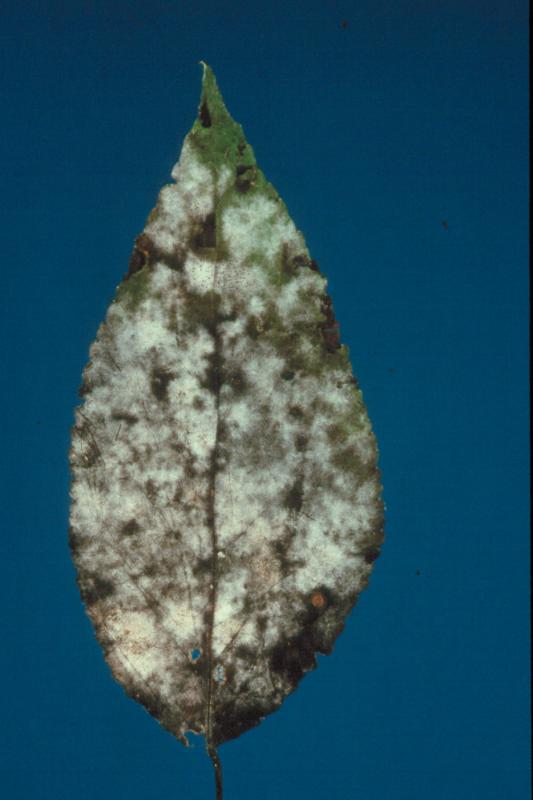
Management
- Collection and burning of fallen leaves.
3. Die back (Diplodia rosarum)
Symptoms
- Drying of twigs from tip down wards.
- Blackening of the twigs.
- The disease spreads to root and causes complete killing of the plants.
Management
- Pruning should be done so that lesions on the young shoots will be eliminated. Apply chaubatia pastic in the pruned area.
4. Rust (Phragmidum mucronatum)
Symptoms
-
Damage to lemon yellow pustules appear on lower surface of the leaves and stems. Then the colour changes to blackish red.
-
The affected leaves turn yellow deformed and fall prematurely.
-
Die back symptom also appear due to weakening of the plant.
Management
- Collection and burning of fallen leaves.
Disease of Jasmine
Phyllody
Symptoms
Leaves become small malformed and bushy. In the place of flowers green leaf like malformed flowers are formed.
Management
- Selection of cuttings from healthy plants.
Disease of Chrysanthemum
Rust (Puccinia crysanthemi)
Rust is a serious disease especially in the early spring.
- The disease symptoms are in the form of brown blister-like swellings, which appear on the undersides of leaves.
- These burst open releasing masses of brown, powdery spores. Severely infected plants become very weak and fail to bloom properly.
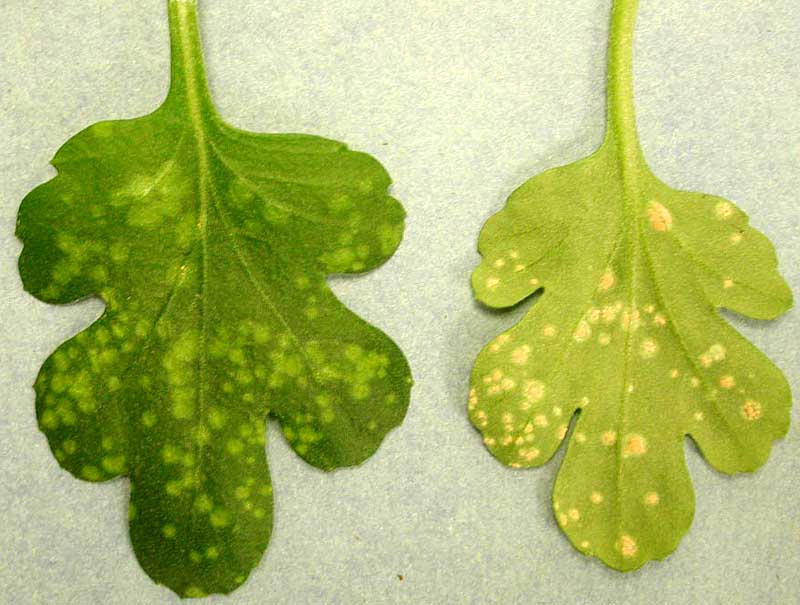
Management
- Early removal of infected leaves/plants helps to prevent the further spread of the disease.
Septoria Leaf Spot (Sepotria chrysanthemella)
Leaf spots occur during cool-wet periods of the rainy season.
- Since the pathogens are spread through rain splashes the lowermost leaves get infected first.
- Serious infection may result in premature withering of the leaves; the dead leaves hang to the stem for some time.
- When flowering starts the infection occurs on flower buds, which rot completely.
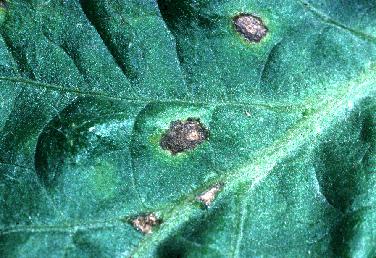
Management
- Destruction of disease debris and avoiding excessive irrigation is recommended.
Powdery Mildew (Oidium chrysanthemi)
Infection is more severe in older plants under humid conditions.
- The growth of the fungus on the leaves appears as powdery coating. Infected leaves turn yellow and dry out.
- Infected plants remains stunted and fail to flower.
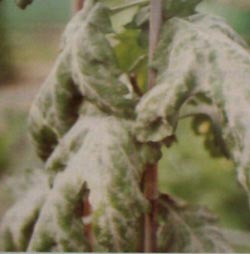
Management
Diseases of Carnation
1. Fusarium wilt (Fusarium oxysporum f.sp. dianthi)
Symptoms
In young plants, the first sign of the disease is fading or graying of the normal colour of the leaves with wilting of the leaves and young stems. It is followed by eventual collapse of the whole plant. When older plants are infected, similar symptoms are produced but the older leaves may show chlorosis followed by an indistinct purple-red discoloration. The vascular tissues of infected stems is stained dark brown. Mature plants show wilt symptoms over a period of several months before they die and eventually become straw coloured.
Fungus :
Management
The diseased plants should be removed immediately after noticing the disease. Complete root system and surrounding soil should be dug out and disposed off carefully. Soil solarization using clear transparent polyethylene film (0.1 mm thick) for 30 days gives satisfactory control. Grafting of susceptible cultivars like A
lice, Fulvio Rosa, Gus Royalette and Johy, on to resistant rootstocks i.e. Arancio 25D, Exquisite, Heidi and May Britt and growing in soil naturally infested with fungus was also found to reduce the incidence of disease.
2. Alternaria leaf spot (Alternaria dianthi)
Symptoms
The chief symptom is blight or rot at leaf bases and around nodes, which are girdled. Spots on leaves are ashy white. The centre of old spots are covered with dark brown to black fungal growth. Leaves may be constricted and twisted and the tip may be killed. Branches die-back at the girdled area and black crusts of conidia are formed on the cankers.
Management
To reduce the disease incidence, humidity may be kept low by providing proper air circulation. Disease-free planting material should be used.
3. Bacterial wilt (Burkholderia caryophylli)
Symptoms
The upper parts of established plants turn pale and wilt.The stem develops elongated discolored stripes and split open which is characteristic of the disease.The roots are rotted partially and the cortical tissues become sticky and shows discoloration, a tendency to straighten out instead of remaining curled. The leaves are twisted. The roots are generally lacking on one side and remain discolored. The base of the cutting is discolored, with an elongated brown area extending upwards.The bacteria invade xylem vessels and spread to infect the young shoots. The vessels are disrupted and the host plant produces meristematic tissues. This new tissue causes an uneven development of cortex which splits open longitudinally. Carnation wilt, a vascular disease may be induced by mechanical plugging, a toxin or a combination of factors. Carnation cuttings wilted when placed in a filtrate of a bacterial suspension of B. caryophylli. In the naturally infected carnation plants the xylem vessels are found partly plugged. Lysis of xylem vessels, is also observed. Infection is carried to upper portions of the branch into the leaves. Bacteria are not found in parenchyma tissues. Carnation cuttings suspended in bacterial filtrates in which proteins and other large molecular compounds are removed did not wilting symptoms.
Management
Use of cuttings taken from upper parts of the healthy stock plants are less liable for infection and hence advocated as a control measure. Diseased plant debris should be collected and burnt. Overhead watering and splash watering should be avoided. Disease-free planting materials are to be used. Role cultivars viz., Elegance, Northland and Starlite are less susceptible to bacterial wilt.
Diseases of Gerbera (Gerbera asplenifolia, G. aurantiaca, G. jamesonii (Barbeton daisy), G. Kunzeane and G.viridfolla)
1. Root rot (Rhizoctonia solani Kuhn and Pythium irregualsre)
The infection result in stunted growth. Ultimately the entire plant dry. Rhizoctonia solani causes more losses and can attack older plants. Soil sterilization controls the diseases.
2. Foot rot and root rot (Phytophthora cryptogeas)
The short stems blacken and rot. The leaves and flower die. Soil sterilization with vampam at 100 ml/square meter is very effective. Warming of soil (26° C) reduces the incidence of the disease.
3. Blight / Grey mould (Botrytis cinera Pers)
The fungus kills young growing tissues. The flower heads of the Gerbera growing in humid conditions show small, black spots on the ray florets. Deep planting, poor drainage and poor ventilation predispose the plants to infection. The disease can be reduced when the infected parts are removed and destroyed.
4. Powdery mildew (Erysiphe chichoracearum DC and Oidium erysiphoides f.sp. gerbera)
The fungus forms white powdery coating on the foliage. Spraying with wettabel sulphur controls E. Chichoracearum. Diseased leaves should be removed and destroyed.
5. Anthracnose (Colletotrichum gloeosporiodes Penz)
On Gerbera jamesonii Bolus ex. Hook.f. It has been reported from Karnataka and Maharashtra. The disease appears as circular, scattered, reddish brown spots. They coalesce with one another during moist weather involving large area and resulting in withering, rolling and drying of leaves. Excessive watering and crowding of plants should be avoided. Diseased leaves should be collected and burnt.
8. Blossom blight asnd stalk rot (Phytophythora palmivoras Butler)
It was reported from Maharashtra during 1971 and Karnataka. The disease appears as light brown, irregular, water soaked spots on flower stalks and petals. The spots increase rapidly and coalesce with one another and form distinct depressed lesions. Under humid conditions the infections become severe involving the entire flower head and resulting in blossom blight and stalk rot. The disease is favoured by drizzling rains and cool moist weather. The fungus is soil-borne and the infection starts from the base touching the soil. Use of disease free soil for cultivation reduces the disease incidence. Affected flowers should be collected and destroyed. Excessive watering should be avoided
9. Tobacco rattle (Tobacco rattle virus)
Yellow or black annulated ring spots asre observed on the foliage. Soil steaming before each crop destroys the nematode vector, Trichodorus spp. and prevents the disease.
|
|
|

















